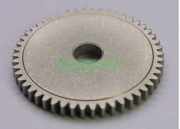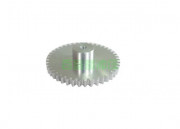Posted at 29/07/2022 By : deep drawing Categories : Blog,Industry Comment: Comments Off on Processing characteristics of metal stamping parts and sample processing of simple stamping dies Metal stamping parts are very common in daily life, so the metal stamping processing industry has been widely used. Currently, there are more than ten hardware products and hundreds of products on the metal market. Mainly include: locks, tensioning, door and window hardware, home decoration hardware, HVAC hardware, architectural decoration hardware, tools, bathroom hardware, kitchen hardware, etc. But in the processing of metal stamping parts, some problems will inevitably be encountered, how to deal with and deal with? The following editors of Zhejiang Baifudu Electromechanical will take you to understand the processing characteristics of metal stamping parts and the simple processing of stamping mold samples!
Metal stamping parts rely on presses and dies to apply external forces to plates, steel bars, pipes and profiles to plastically deform or separate, so as to obtain the forming and processing methods of workpieces of desired shape and size. In the stamping process, if the quality of the section and the dimensional accuracy of the workpiece are high, it can be repaired or used directly after stamping. In the production process of precision stamping parts, in order to improve the stability of stamping parts, the number of processes must be increased.
Metal stamping products have a long manufacturing cycle, many processes, and many abnormal situations (involving rework, scrap, split, replenishment, replacement, buffer materials, etc.), and the production process requires tracking and cost analysis. In addition, during the production process, customers can insert orders in time according to market changes, which is unpredictable by hardware companies. Relying on manual management, of course, cannot meet the change requirements of customer orders. Only after the order is confirmed, can it be included in the management. Sometimes the order status changes, but there is no timely response, often in a hurry. This shows that how to start information construction has become the primary problem facing hardware enterprise decision makers.
As a highly isolated industry, metal stamping parts often encounter bottlenecks under traditional manual management in daily production. First of all, the market competition is fierce, and user needs are constantly changing. Many hardware companies mainly focus on small batches and medium batches, and the design and manufacturing process of products often change according to customer needs. Therefore, hardware companies need to develop a good production plan to improve the flexibility of production and enable it to adapt to the market. The author believes that the products of general hardware enterprises are produced according to orders (contracts), the product structure is complex, the parts are many, outsourced and self-made. In the production process, relying on traditional manual management to rationally optimize production, the workload of production management is very large. The information and data of the department cannot be shared in a unified standard and interface, and it is inevitable that the delivery time cannot be scientifically controlled, which affects the execution rate of the order.
Second, metal stamping parts manufacturers have many outsourcing factories, involving many outsourcing factories, using traditional manual management methods, how to track and control the product quality, price, reputation of the metal stamping factory, and how the purchasing department controls the advance quantity, Ensuring that production does not go wrong, does not cause inventory backlog, and ensures a more reasonable level of capital occupation is a headache for hardware companies.
In many cases, the number of operations of a bent part is mainly determined by the complexity of its structural shape, which is determined by the number of bending angles. If the bending radius of the curved part is smaller than the allowable value, an additional forming process is required. Similarly, the number of processes and material properties of the drawn part, the drawing height, the number of drawing steps, the drawing diameter, the material thickness and other conditions are also affected and need to be determined by drawing process calculations. If the corner radius of the drawn part is small, or there is a certain requirement for dimensional accuracy, another forming process needs to be added after drawing. According to this model, the number of processes to determine stamping parts should also meet the conditions of the company’s existing mold capacity and stamping equipment. The molding ability should ensure mold processing, and the requirements for assembly accuracy should be improved accordingly, otherwise the number of processes can only be increased. For simple blanking parts, single-pass stamping dies are used; on the contrary, due to the limitation of die structure or strength, the inner and outer contours of complex stamping dies should be divided into multiple parts, requiring multiple stamping processes.
Recently, after receiving quotations for metal stamping products, many customers suggest to make some simple stamping dies to make some samples for testing. For these customers, we recommend customers not to make simple molds from the beginning. Especially for the following reasons:
1. Stamping parts that basically meet the requirements of the drawings cannot be produced.
The customer wants to use a simple mold as a sample, but has not confirmed the product in the early stage, and wants to spend less mold cost to test the sample. However, dimensional accuracy cannot be guaranteed for products manufactured by simple molds, even if the customer cannot be sure of the dimensional failure caused by the product.
2. A simple die cannot guarantee the uniformity of stamping parts.
A simple die cannot guarantee that each die is the same, because a simple die often does not have accessories such as positioning and guide posts, and there will be different offsets for each punch, which leads customers to inspect the stamping parts. , no satisfactory results can be obtained.
3. Failure to mass-produce simple stamping dies will result in waste.
The simple-packed punching meme has a simple structure and low precision, and can only be mass-produced after the customer confirms the sample. This will cause a lot of waste.
In fact, if the customer does not confirm the stamping product in the later stage, there is basically no need to open a simple die for sample testing, and other processing techniques can be considered to achieve it. Most steels are stamped, and punching can be made by other methods with ribs, ribs, undulations, or flanging to increase stiffness.
The above is the relevant content of metal stamping parts processing. In short, processing products through stamping process has become an important means and development direction of modern industrial production. However, the disadvantages of stamping parts are high mold requirements, complex manufacturing, long cycle and high manufacturing cost, which limit small batch production. Therefore, most stamping parts are mass-produced, which also reflects the importance of molds. I hope it helps readers.
Read More →





















